Accounting Issues in Business Combination: Power Ltd Memo and Analysis
VerifiedAdded on 2022/11/26
|9
|2056
|233
Report
AI Summary
This assignment is a memorandum prepared by a graduate accountant for Power Ltd, addressing accounting issues arising from the potential acquisition of Cargo Limited. The memo, directed to the company's director, Daniel Ford, analyzes the accounting treatment of business combinations and consolidations in accordance with Australian Accounting Standards (AASB). The memorandum addresses key concerns raised by the board of directors, including the recognition of identifiable assets and liabilities at fair value, the treatment of asset revaluation and the usage of equity accounts, and the existence of equity accounts after the business combination. The memo provides detailed explanations and analysis of these issues, referencing specific paragraphs within AASB 3 and other relevant standards. The memo aims to assist the board in understanding the accounting implications of the acquisition and making informed decisions. The analysis covers topics like the recognition and measurement of assets and liabilities, the treatment of revaluation surplus and losses, and the classification of equity accounts in consolidation worksheets. The memo also addresses the impact of share-based payments and the treatment of contingent consideration. The assignment also required a video presentation summarizing the key findings of the memo.

Running head: FINANCIAL ACCOUNTING AND REPORTING
Financial accounting and reporting
Name of the student
Name of the university
Student ID
Author note
Financial accounting and reporting
Name of the student
Name of the university
Student ID
Author note
Paraphrase This Document
Need a fresh take? Get an instant paraphrase of this document with our AI Paraphraser
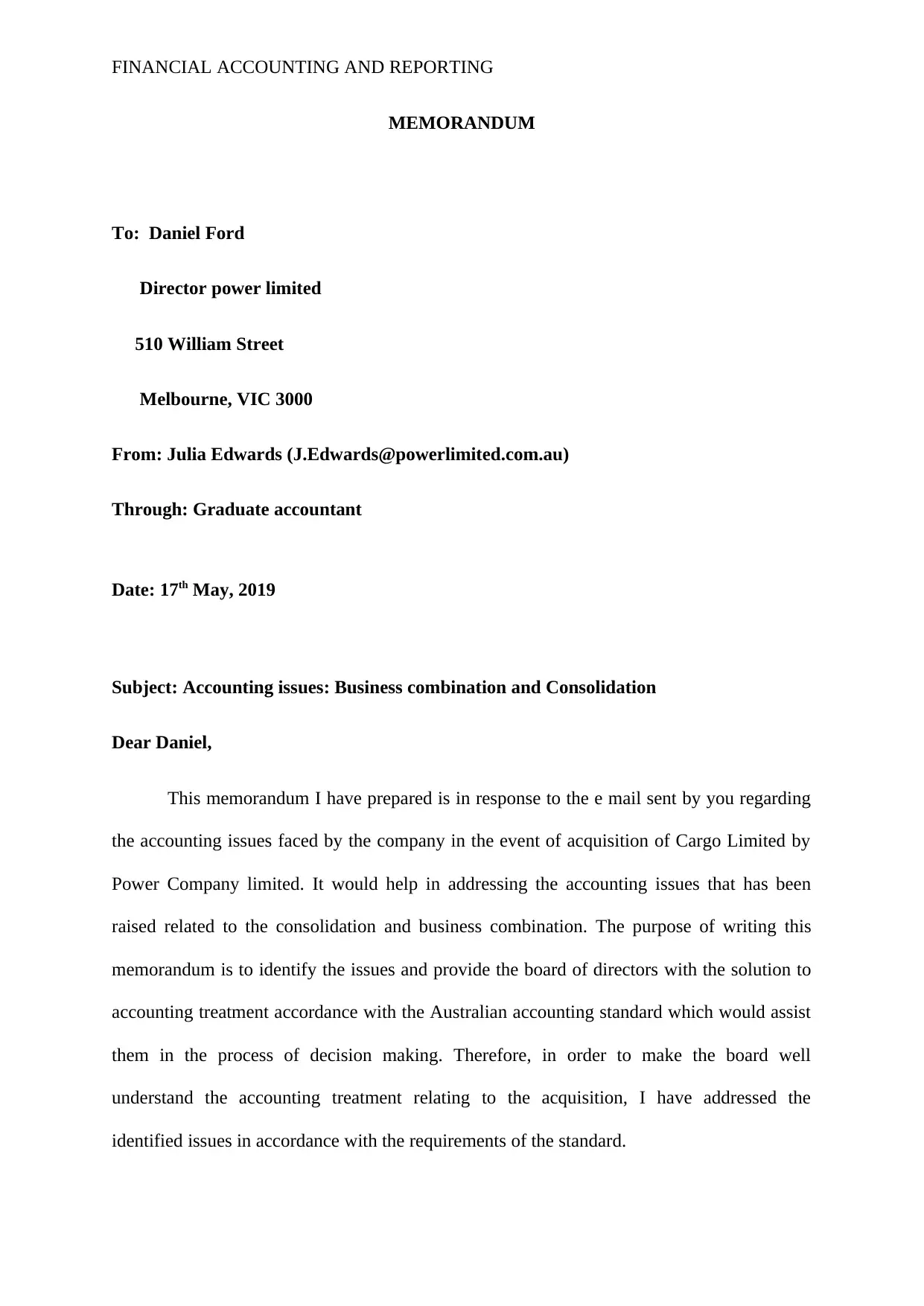
FINANCIAL ACCOUNTING AND REPORTING
MEMORANDUM
To: Daniel Ford
Director power limited
510 William Street
Melbourne, VIC 3000
From: Julia Edwards (J.Edwards@powerlimited.com.au)
Through: Graduate accountant
Date: 17th May, 2019
Subject: Accounting issues: Business combination and Consolidation
Dear Daniel,
This memorandum I have prepared is in response to the e mail sent by you regarding
the accounting issues faced by the company in the event of acquisition of Cargo Limited by
Power Company limited. It would help in addressing the accounting issues that has been
raised related to the consolidation and business combination. The purpose of writing this
memorandum is to identify the issues and provide the board of directors with the solution to
accounting treatment accordance with the Australian accounting standard which would assist
them in the process of decision making. Therefore, in order to make the board well
understand the accounting treatment relating to the acquisition, I have addressed the
identified issues in accordance with the requirements of the standard.
MEMORANDUM
To: Daniel Ford
Director power limited
510 William Street
Melbourne, VIC 3000
From: Julia Edwards (J.Edwards@powerlimited.com.au)
Through: Graduate accountant
Date: 17th May, 2019
Subject: Accounting issues: Business combination and Consolidation
Dear Daniel,
This memorandum I have prepared is in response to the e mail sent by you regarding
the accounting issues faced by the company in the event of acquisition of Cargo Limited by
Power Company limited. It would help in addressing the accounting issues that has been
raised related to the consolidation and business combination. The purpose of writing this
memorandum is to identify the issues and provide the board of directors with the solution to
accounting treatment accordance with the Australian accounting standard which would assist
them in the process of decision making. Therefore, in order to make the board well
understand the accounting treatment relating to the acquisition, I have addressed the
identified issues in accordance with the requirements of the standard.
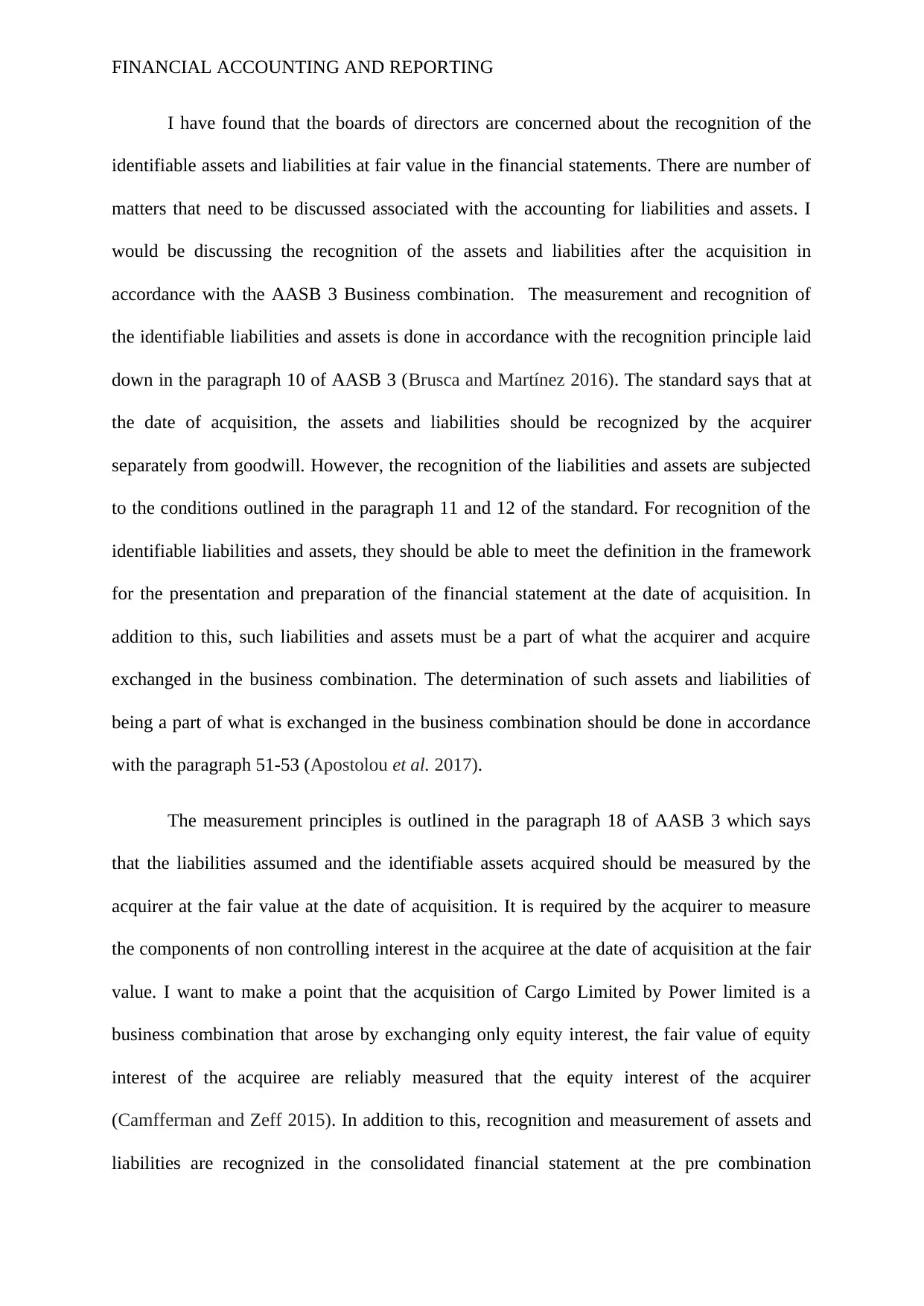
FINANCIAL ACCOUNTING AND REPORTING
I have found that the boards of directors are concerned about the recognition of the
identifiable assets and liabilities at fair value in the financial statements. There are number of
matters that need to be discussed associated with the accounting for liabilities and assets. I
would be discussing the recognition of the assets and liabilities after the acquisition in
accordance with the AASB 3 Business combination. The measurement and recognition of
the identifiable liabilities and assets is done in accordance with the recognition principle laid
down in the paragraph 10 of AASB 3 (Brusca and Martínez 2016). The standard says that at
the date of acquisition, the assets and liabilities should be recognized by the acquirer
separately from goodwill. However, the recognition of the liabilities and assets are subjected
to the conditions outlined in the paragraph 11 and 12 of the standard. For recognition of the
identifiable liabilities and assets, they should be able to meet the definition in the framework
for the presentation and preparation of the financial statement at the date of acquisition. In
addition to this, such liabilities and assets must be a part of what the acquirer and acquire
exchanged in the business combination. The determination of such assets and liabilities of
being a part of what is exchanged in the business combination should be done in accordance
with the paragraph 51-53 (Apostolou et al. 2017).
The measurement principles is outlined in the paragraph 18 of AASB 3 which says
that the liabilities assumed and the identifiable assets acquired should be measured by the
acquirer at the fair value at the date of acquisition. It is required by the acquirer to measure
the components of non controlling interest in the acquiree at the date of acquisition at the fair
value. I want to make a point that the acquisition of Cargo Limited by Power limited is a
business combination that arose by exchanging only equity interest, the fair value of equity
interest of the acquiree are reliably measured that the equity interest of the acquirer
(Camfferman and Zeff 2015). In addition to this, recognition and measurement of assets and
liabilities are recognized in the consolidated financial statement at the pre combination
I have found that the boards of directors are concerned about the recognition of the
identifiable assets and liabilities at fair value in the financial statements. There are number of
matters that need to be discussed associated with the accounting for liabilities and assets. I
would be discussing the recognition of the assets and liabilities after the acquisition in
accordance with the AASB 3 Business combination. The measurement and recognition of
the identifiable liabilities and assets is done in accordance with the recognition principle laid
down in the paragraph 10 of AASB 3 (Brusca and Martínez 2016). The standard says that at
the date of acquisition, the assets and liabilities should be recognized by the acquirer
separately from goodwill. However, the recognition of the liabilities and assets are subjected
to the conditions outlined in the paragraph 11 and 12 of the standard. For recognition of the
identifiable liabilities and assets, they should be able to meet the definition in the framework
for the presentation and preparation of the financial statement at the date of acquisition. In
addition to this, such liabilities and assets must be a part of what the acquirer and acquire
exchanged in the business combination. The determination of such assets and liabilities of
being a part of what is exchanged in the business combination should be done in accordance
with the paragraph 51-53 (Apostolou et al. 2017).
The measurement principles is outlined in the paragraph 18 of AASB 3 which says
that the liabilities assumed and the identifiable assets acquired should be measured by the
acquirer at the fair value at the date of acquisition. It is required by the acquirer to measure
the components of non controlling interest in the acquiree at the date of acquisition at the fair
value. I want to make a point that the acquisition of Cargo Limited by Power limited is a
business combination that arose by exchanging only equity interest, the fair value of equity
interest of the acquiree are reliably measured that the equity interest of the acquirer
(Camfferman and Zeff 2015). In addition to this, recognition and measurement of assets and
liabilities are recognized in the consolidated financial statement at the pre combination
⊘ This is a preview!⊘
Do you want full access?
Subscribe today to unlock all pages.

Trusted by 1+ million students worldwide
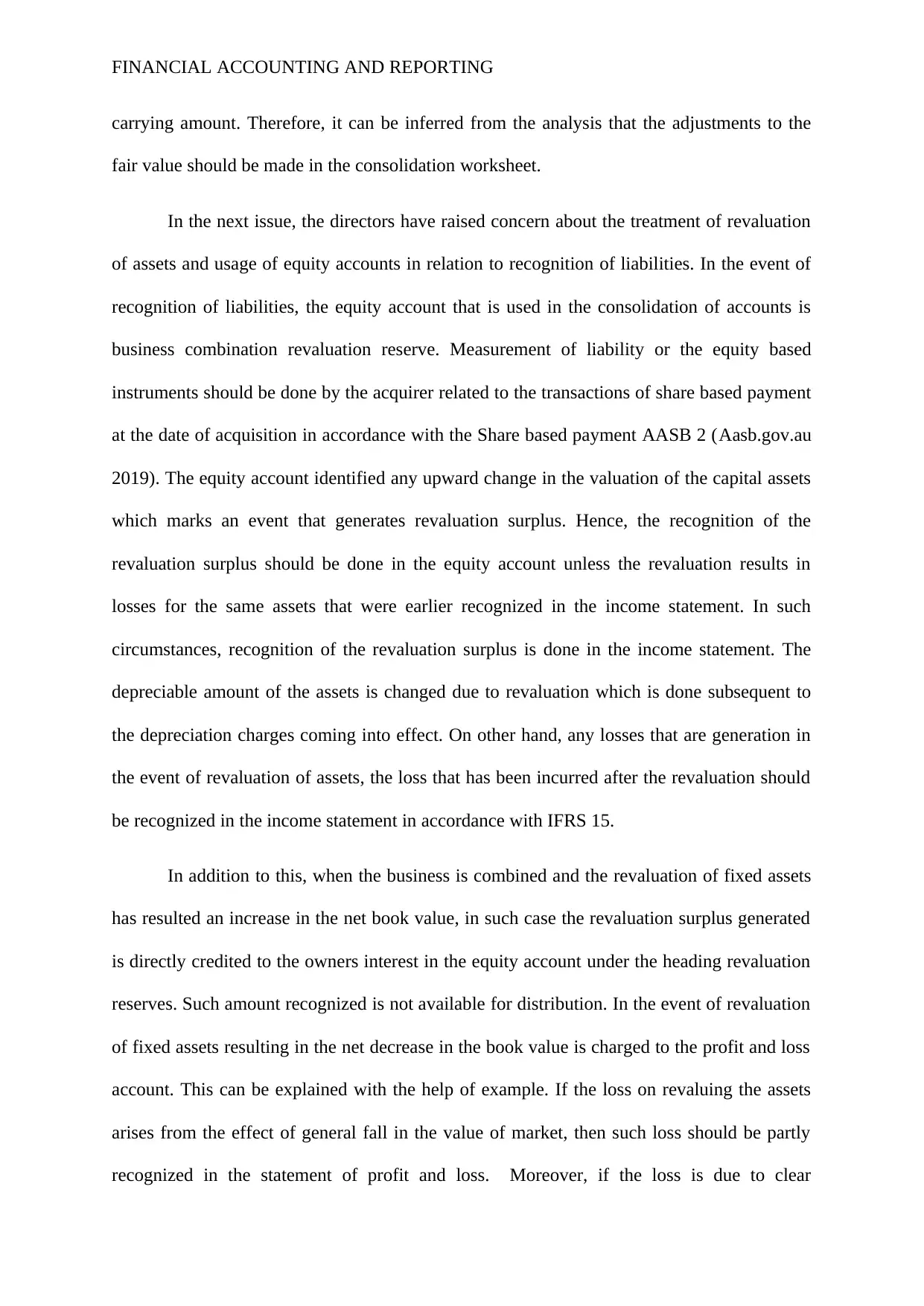
FINANCIAL ACCOUNTING AND REPORTING
carrying amount. Therefore, it can be inferred from the analysis that the adjustments to the
fair value should be made in the consolidation worksheet.
In the next issue, the directors have raised concern about the treatment of revaluation
of assets and usage of equity accounts in relation to recognition of liabilities. In the event of
recognition of liabilities, the equity account that is used in the consolidation of accounts is
business combination revaluation reserve. Measurement of liability or the equity based
instruments should be done by the acquirer related to the transactions of share based payment
at the date of acquisition in accordance with the Share based payment AASB 2 (Aasb.gov.au
2019). The equity account identified any upward change in the valuation of the capital assets
which marks an event that generates revaluation surplus. Hence, the recognition of the
revaluation surplus should be done in the equity account unless the revaluation results in
losses for the same assets that were earlier recognized in the income statement. In such
circumstances, recognition of the revaluation surplus is done in the income statement. The
depreciable amount of the assets is changed due to revaluation which is done subsequent to
the depreciation charges coming into effect. On other hand, any losses that are generation in
the event of revaluation of assets, the loss that has been incurred after the revaluation should
be recognized in the income statement in accordance with IFRS 15.
In addition to this, when the business is combined and the revaluation of fixed assets
has resulted an increase in the net book value, in such case the revaluation surplus generated
is directly credited to the owners interest in the equity account under the heading revaluation
reserves. Such amount recognized is not available for distribution. In the event of revaluation
of fixed assets resulting in the net decrease in the book value is charged to the profit and loss
account. This can be explained with the help of example. If the loss on revaluing the assets
arises from the effect of general fall in the value of market, then such loss should be partly
recognized in the statement of profit and loss. Moreover, if the loss is due to clear
carrying amount. Therefore, it can be inferred from the analysis that the adjustments to the
fair value should be made in the consolidation worksheet.
In the next issue, the directors have raised concern about the treatment of revaluation
of assets and usage of equity accounts in relation to recognition of liabilities. In the event of
recognition of liabilities, the equity account that is used in the consolidation of accounts is
business combination revaluation reserve. Measurement of liability or the equity based
instruments should be done by the acquirer related to the transactions of share based payment
at the date of acquisition in accordance with the Share based payment AASB 2 (Aasb.gov.au
2019). The equity account identified any upward change in the valuation of the capital assets
which marks an event that generates revaluation surplus. Hence, the recognition of the
revaluation surplus should be done in the equity account unless the revaluation results in
losses for the same assets that were earlier recognized in the income statement. In such
circumstances, recognition of the revaluation surplus is done in the income statement. The
depreciable amount of the assets is changed due to revaluation which is done subsequent to
the depreciation charges coming into effect. On other hand, any losses that are generation in
the event of revaluation of assets, the loss that has been incurred after the revaluation should
be recognized in the income statement in accordance with IFRS 15.
In addition to this, when the business is combined and the revaluation of fixed assets
has resulted an increase in the net book value, in such case the revaluation surplus generated
is directly credited to the owners interest in the equity account under the heading revaluation
reserves. Such amount recognized is not available for distribution. In the event of revaluation
of fixed assets resulting in the net decrease in the book value is charged to the profit and loss
account. This can be explained with the help of example. If the loss on revaluing the assets
arises from the effect of general fall in the value of market, then such loss should be partly
recognized in the statement of profit and loss. Moreover, if the loss is due to clear
Paraphrase This Document
Need a fresh take? Get an instant paraphrase of this document with our AI Paraphraser

FINANCIAL ACCOUNTING AND REPORTING
consumption of economic benefits say from the physical damage to the assets, then the loss is
recognized in the statement of profit and loss as operating cost. Therefore, from the analysis
of the different case resulting in the revaluation of assets, it is concluded that the revaluation
surplus is recognized as reserve in the equity account and loss on revaluation is partly and
completely recognized on the statement of profit and loss depending upon the circumstances
(Chychyla et al. 2019). Thus, it is said that equity accounts is used when revaluation
generates surplus and profit and loss accounts should be used when revaluation generates
losses. Hence, different equity accounts are used in relation to recognition of liabilities.
The third issue that has being into the concern of directors is the existence of equity
accounts. This issue has come into the picture because the directors view that the equity
account after the business combination do not seem to be related to the equity account that is
recognized by Cargo limited. This particular issue is explained in accordance with the
relevant accounting standard. After the acquisition of Cargo Pty limited by Power Company
Limited, the equity account is prepared in the consolidated worksheet and thereby there is not
the separate existence of the equity account of Cargo limited. The equity account recognized
by the acquired company is no longer a part of equity account of Cargo limited. Furthermore,
the acquirer is required to classify the payment obligation for contingent consideration in
order to meet the definition of financial instruments as financial liability according to the
paragraph 11 of AASB 132 financial instruments (Tassadaq and Malik 2015).
The acquirer should remeasure the previously held equity interest at the date of
acquisition at fair value and when considered appropriate, the resulting loss and gain should
be recognized in the comprehensive income statement. Accordance with the standard,
acquirer is the entity that usually issues equity in the business combination which is primarily
impacted by exchanging the equity interest. However, in some of the situation such as the
event of reverse acquisition, equity is issued by the acquiree. The new entity formed after the
consumption of economic benefits say from the physical damage to the assets, then the loss is
recognized in the statement of profit and loss as operating cost. Therefore, from the analysis
of the different case resulting in the revaluation of assets, it is concluded that the revaluation
surplus is recognized as reserve in the equity account and loss on revaluation is partly and
completely recognized on the statement of profit and loss depending upon the circumstances
(Chychyla et al. 2019). Thus, it is said that equity accounts is used when revaluation
generates surplus and profit and loss accounts should be used when revaluation generates
losses. Hence, different equity accounts are used in relation to recognition of liabilities.
The third issue that has being into the concern of directors is the existence of equity
accounts. This issue has come into the picture because the directors view that the equity
account after the business combination do not seem to be related to the equity account that is
recognized by Cargo limited. This particular issue is explained in accordance with the
relevant accounting standard. After the acquisition of Cargo Pty limited by Power Company
Limited, the equity account is prepared in the consolidated worksheet and thereby there is not
the separate existence of the equity account of Cargo limited. The equity account recognized
by the acquired company is no longer a part of equity account of Cargo limited. Furthermore,
the acquirer is required to classify the payment obligation for contingent consideration in
order to meet the definition of financial instruments as financial liability according to the
paragraph 11 of AASB 132 financial instruments (Tassadaq and Malik 2015).
The acquirer should remeasure the previously held equity interest at the date of
acquisition at fair value and when considered appropriate, the resulting loss and gain should
be recognized in the comprehensive income statement. Accordance with the standard,
acquirer is the entity that usually issues equity in the business combination which is primarily
impacted by exchanging the equity interest. However, in some of the situation such as the
event of reverse acquisition, equity is issued by the acquiree. The new entity formed after the
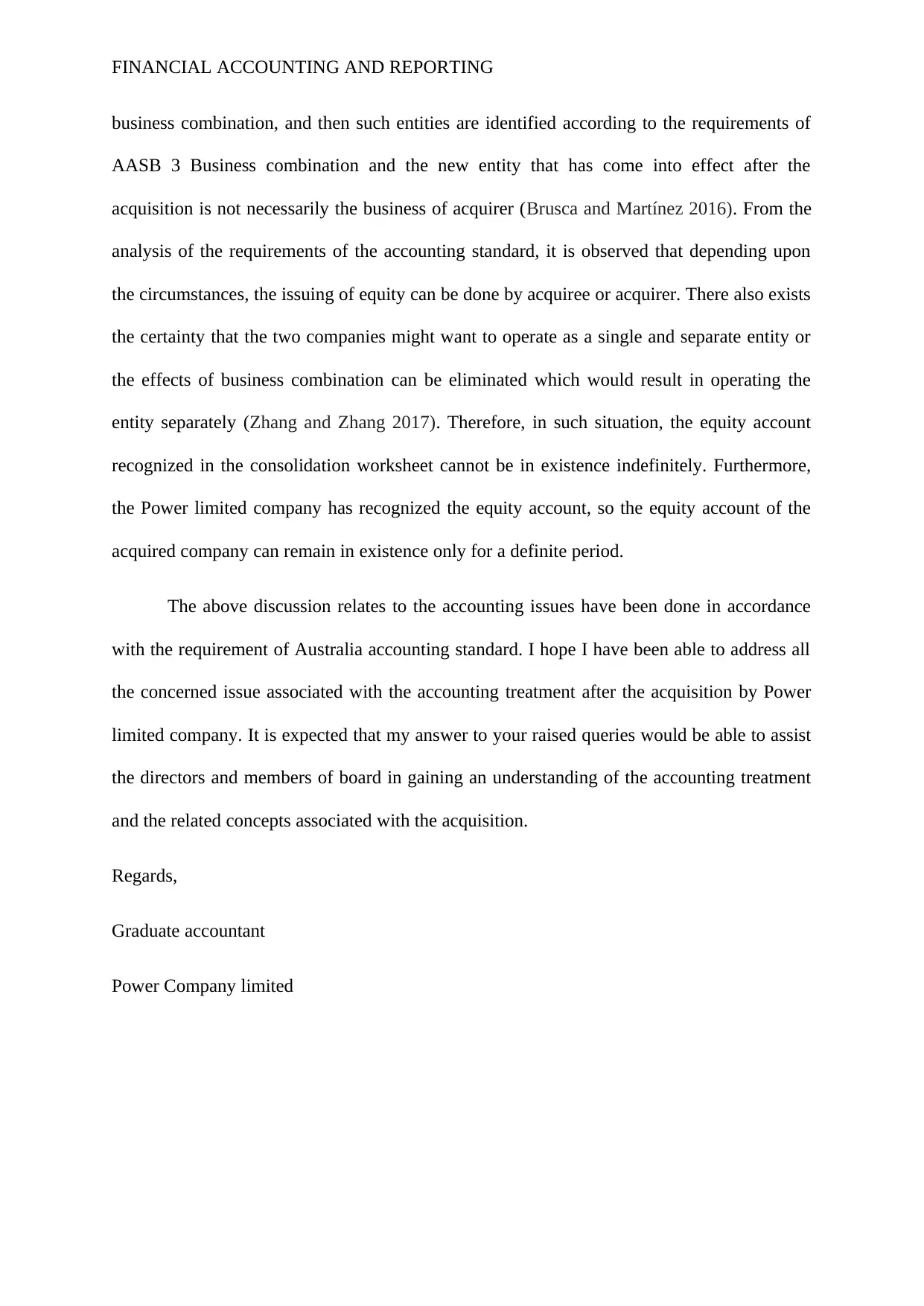
FINANCIAL ACCOUNTING AND REPORTING
business combination, and then such entities are identified according to the requirements of
AASB 3 Business combination and the new entity that has come into effect after the
acquisition is not necessarily the business of acquirer (Brusca and Martínez 2016). From the
analysis of the requirements of the accounting standard, it is observed that depending upon
the circumstances, the issuing of equity can be done by acquiree or acquirer. There also exists
the certainty that the two companies might want to operate as a single and separate entity or
the effects of business combination can be eliminated which would result in operating the
entity separately (Zhang and Zhang 2017). Therefore, in such situation, the equity account
recognized in the consolidation worksheet cannot be in existence indefinitely. Furthermore,
the Power limited company has recognized the equity account, so the equity account of the
acquired company can remain in existence only for a definite period.
The above discussion relates to the accounting issues have been done in accordance
with the requirement of Australia accounting standard. I hope I have been able to address all
the concerned issue associated with the accounting treatment after the acquisition by Power
limited company. It is expected that my answer to your raised queries would be able to assist
the directors and members of board in gaining an understanding of the accounting treatment
and the related concepts associated with the acquisition.
Regards,
Graduate accountant
Power Company limited
business combination, and then such entities are identified according to the requirements of
AASB 3 Business combination and the new entity that has come into effect after the
acquisition is not necessarily the business of acquirer (Brusca and Martínez 2016). From the
analysis of the requirements of the accounting standard, it is observed that depending upon
the circumstances, the issuing of equity can be done by acquiree or acquirer. There also exists
the certainty that the two companies might want to operate as a single and separate entity or
the effects of business combination can be eliminated which would result in operating the
entity separately (Zhang and Zhang 2017). Therefore, in such situation, the equity account
recognized in the consolidation worksheet cannot be in existence indefinitely. Furthermore,
the Power limited company has recognized the equity account, so the equity account of the
acquired company can remain in existence only for a definite period.
The above discussion relates to the accounting issues have been done in accordance
with the requirement of Australia accounting standard. I hope I have been able to address all
the concerned issue associated with the accounting treatment after the acquisition by Power
limited company. It is expected that my answer to your raised queries would be able to assist
the directors and members of board in gaining an understanding of the accounting treatment
and the related concepts associated with the acquisition.
Regards,
Graduate accountant
Power Company limited
⊘ This is a preview!⊘
Do you want full access?
Subscribe today to unlock all pages.

Trusted by 1+ million students worldwide
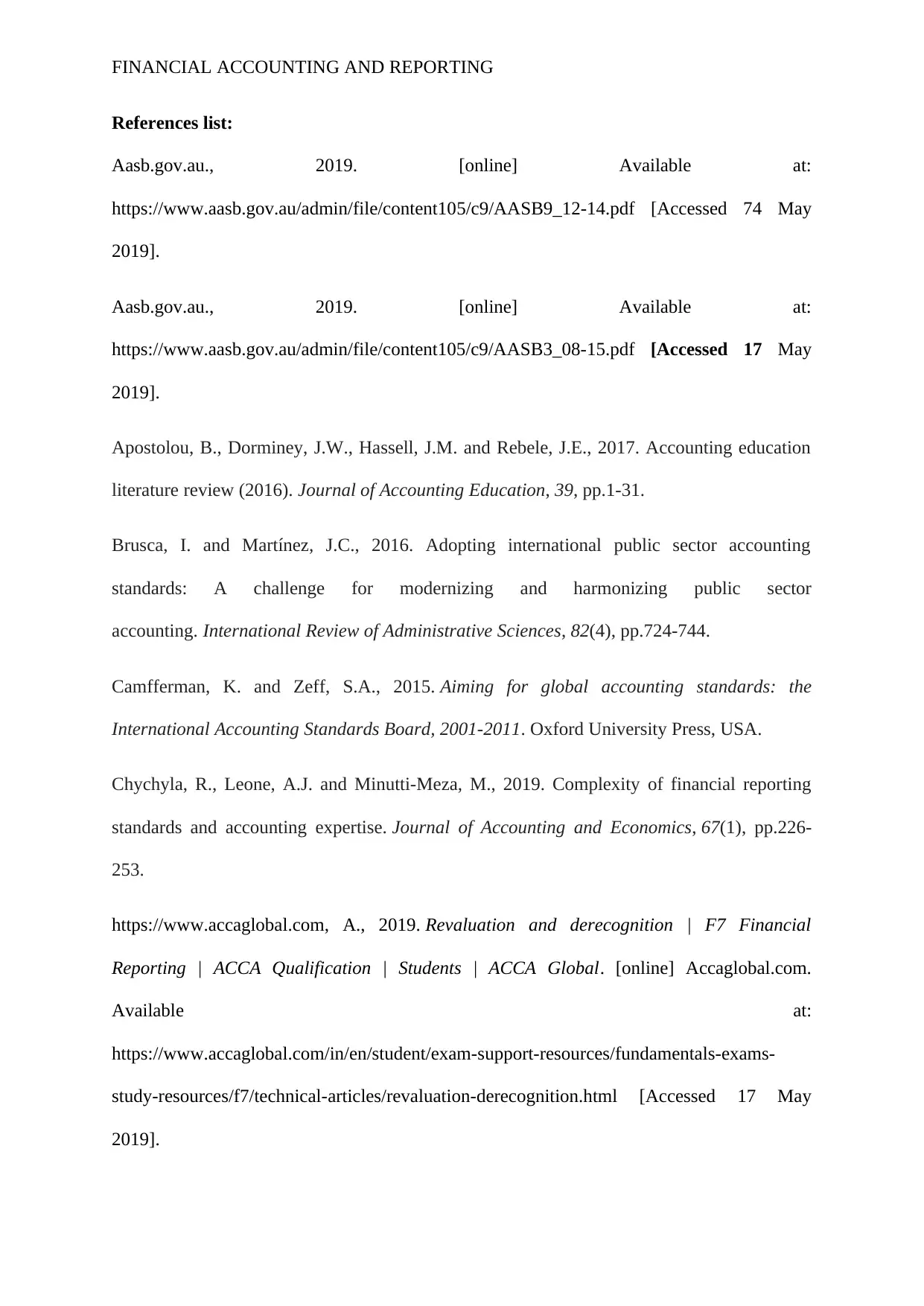
FINANCIAL ACCOUNTING AND REPORTING
References list:
Aasb.gov.au., 2019. [online] Available at:
https://www.aasb.gov.au/admin/file/content105/c9/AASB9_12-14.pdf [Accessed 74 May
2019].
Aasb.gov.au., 2019. [online] Available at:
https://www.aasb.gov.au/admin/file/content105/c9/AASB3_08-15.pdf [Accessed 17 May
2019].
Apostolou, B., Dorminey, J.W., Hassell, J.M. and Rebele, J.E., 2017. Accounting education
literature review (2016). Journal of Accounting Education, 39, pp.1-31.
Brusca, I. and Martínez, J.C., 2016. Adopting international public sector accounting
standards: A challenge for modernizing and harmonizing public sector
accounting. International Review of Administrative Sciences, 82(4), pp.724-744.
Camfferman, K. and Zeff, S.A., 2015. Aiming for global accounting standards: the
International Accounting Standards Board, 2001-2011. Oxford University Press, USA.
Chychyla, R., Leone, A.J. and Minutti-Meza, M., 2019. Complexity of financial reporting
standards and accounting expertise. Journal of Accounting and Economics, 67(1), pp.226-
253.
https://www.accaglobal.com, A., 2019. Revaluation and derecognition | F7 Financial
Reporting | ACCA Qualification | Students | ACCA Global. [online] Accaglobal.com.
Available at:
https://www.accaglobal.com/in/en/student/exam-support-resources/fundamentals-exams-
study-resources/f7/technical-articles/revaluation-derecognition.html [Accessed 17 May
2019].
References list:
Aasb.gov.au., 2019. [online] Available at:
https://www.aasb.gov.au/admin/file/content105/c9/AASB9_12-14.pdf [Accessed 74 May
2019].
Aasb.gov.au., 2019. [online] Available at:
https://www.aasb.gov.au/admin/file/content105/c9/AASB3_08-15.pdf [Accessed 17 May
2019].
Apostolou, B., Dorminey, J.W., Hassell, J.M. and Rebele, J.E., 2017. Accounting education
literature review (2016). Journal of Accounting Education, 39, pp.1-31.
Brusca, I. and Martínez, J.C., 2016. Adopting international public sector accounting
standards: A challenge for modernizing and harmonizing public sector
accounting. International Review of Administrative Sciences, 82(4), pp.724-744.
Camfferman, K. and Zeff, S.A., 2015. Aiming for global accounting standards: the
International Accounting Standards Board, 2001-2011. Oxford University Press, USA.
Chychyla, R., Leone, A.J. and Minutti-Meza, M., 2019. Complexity of financial reporting
standards and accounting expertise. Journal of Accounting and Economics, 67(1), pp.226-
253.
https://www.accaglobal.com, A., 2019. Revaluation and derecognition | F7 Financial
Reporting | ACCA Qualification | Students | ACCA Global. [online] Accaglobal.com.
Available at:
https://www.accaglobal.com/in/en/student/exam-support-resources/fundamentals-exams-
study-resources/f7/technical-articles/revaluation-derecognition.html [Accessed 17 May
2019].
Paraphrase This Document
Need a fresh take? Get an instant paraphrase of this document with our AI Paraphraser
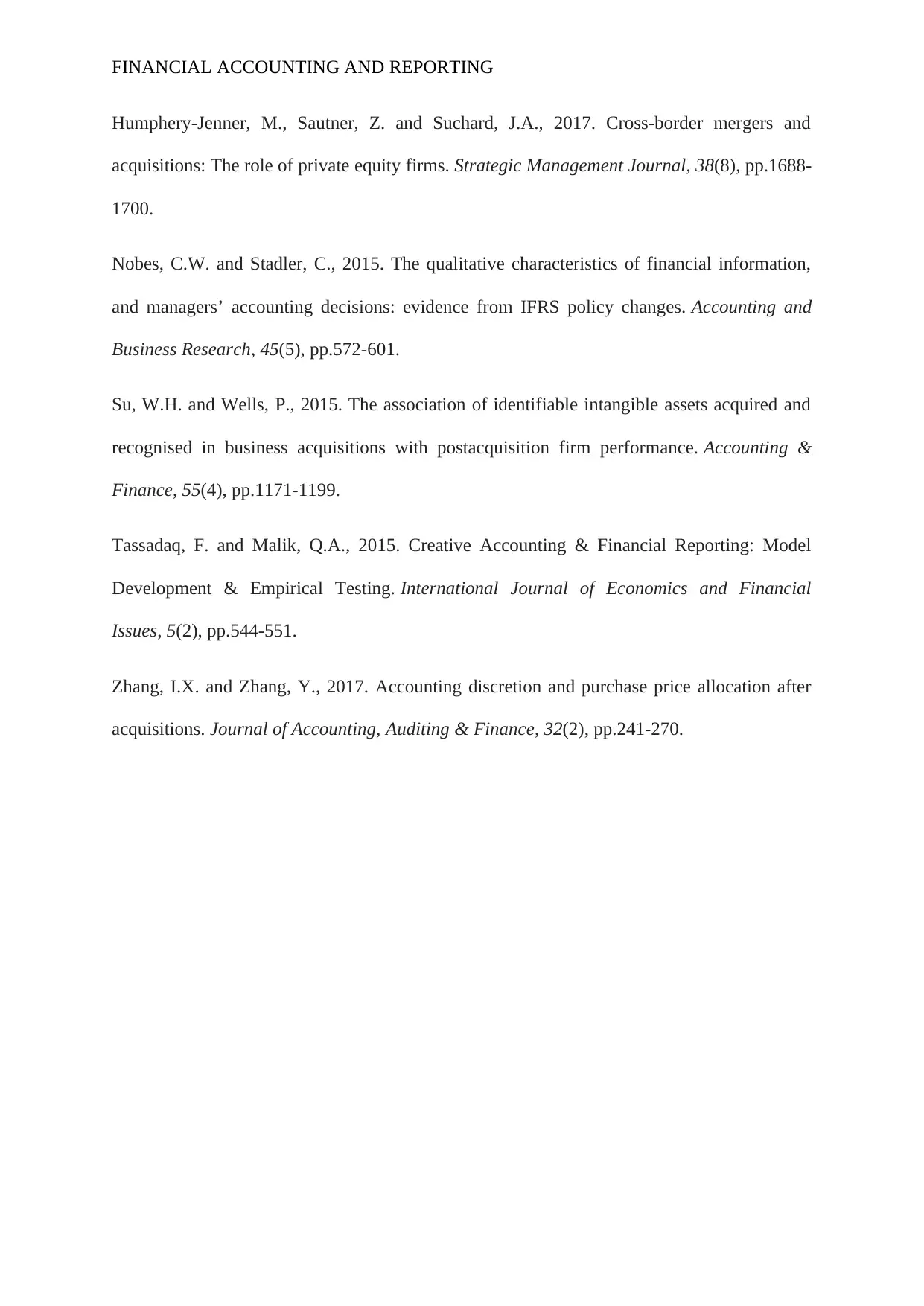
FINANCIAL ACCOUNTING AND REPORTING
Humphery‐Jenner, M., Sautner, Z. and Suchard, J.A., 2017. Cross‐border mergers and
acquisitions: The role of private equity firms. Strategic Management Journal, 38(8), pp.1688-
1700.
Nobes, C.W. and Stadler, C., 2015. The qualitative characteristics of financial information,
and managers’ accounting decisions: evidence from IFRS policy changes. Accounting and
Business Research, 45(5), pp.572-601.
Su, W.H. and Wells, P., 2015. The association of identifiable intangible assets acquired and
recognised in business acquisitions with postacquisition firm performance. Accounting &
Finance, 55(4), pp.1171-1199.
Tassadaq, F. and Malik, Q.A., 2015. Creative Accounting & Financial Reporting: Model
Development & Empirical Testing. International Journal of Economics and Financial
Issues, 5(2), pp.544-551.
Zhang, I.X. and Zhang, Y., 2017. Accounting discretion and purchase price allocation after
acquisitions. Journal of Accounting, Auditing & Finance, 32(2), pp.241-270.
Humphery‐Jenner, M., Sautner, Z. and Suchard, J.A., 2017. Cross‐border mergers and
acquisitions: The role of private equity firms. Strategic Management Journal, 38(8), pp.1688-
1700.
Nobes, C.W. and Stadler, C., 2015. The qualitative characteristics of financial information,
and managers’ accounting decisions: evidence from IFRS policy changes. Accounting and
Business Research, 45(5), pp.572-601.
Su, W.H. and Wells, P., 2015. The association of identifiable intangible assets acquired and
recognised in business acquisitions with postacquisition firm performance. Accounting &
Finance, 55(4), pp.1171-1199.
Tassadaq, F. and Malik, Q.A., 2015. Creative Accounting & Financial Reporting: Model
Development & Empirical Testing. International Journal of Economics and Financial
Issues, 5(2), pp.544-551.
Zhang, I.X. and Zhang, Y., 2017. Accounting discretion and purchase price allocation after
acquisitions. Journal of Accounting, Auditing & Finance, 32(2), pp.241-270.

FINANCIAL ACCOUNTING AND REPORTING
Bibliography:
Bibliography:
⊘ This is a preview!⊘
Do you want full access?
Subscribe today to unlock all pages.

Trusted by 1+ million students worldwide
1 out of 9
Related Documents
Your All-in-One AI-Powered Toolkit for Academic Success.
+13062052269
info@desklib.com
Available 24*7 on WhatsApp / Email
![[object Object]](/_next/static/media/star-bottom.7253800d.svg)
Unlock your academic potential
Copyright © 2020–2025 A2Z Services. All Rights Reserved. Developed and managed by ZUCOL.





